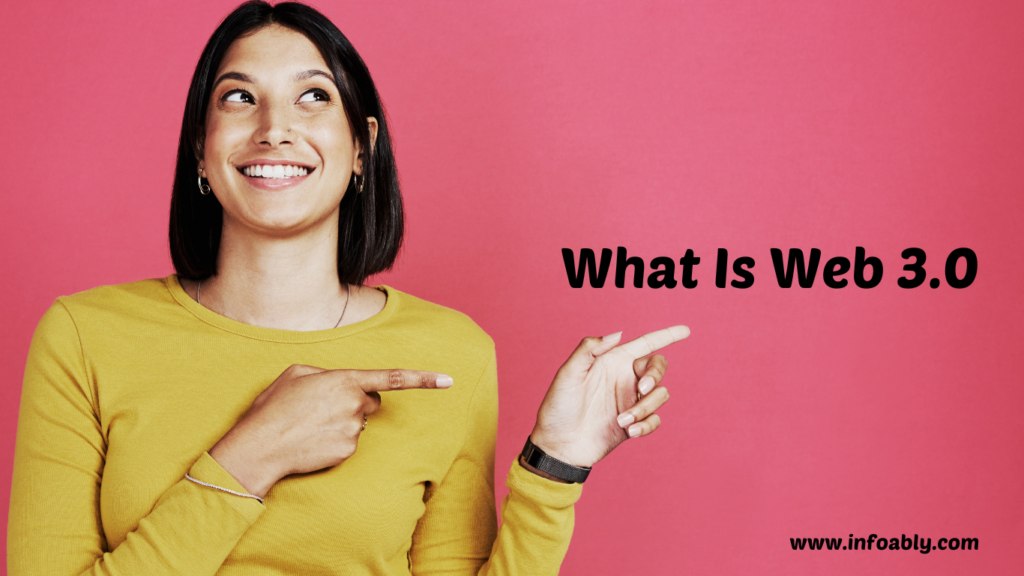Today in this article we will see What Is Web 3.0? Web 3.0 is a future version of the world wide web which is also called web 3. It is the future of the internet and of google too. As we know that the current world wide web is very fast and it provides many services, so the speed and abilities of web 3 are yet to be known.
Therefore we can only see the examples and some of the early samples of web 3 which has already changed many things over the Internet. Web 3 is the next generation of the web, coming with many extraordinary features that we can not think of right now. In web 3, users will be connected through a decentralized network and will also have access to most of their data.
The internet has come a long way since its inception, evolving from static web pages to interactive platforms that facilitate communication, collaboration, and the sharing of information. Web 2.0 revolutionized the internet by introducing user-generated content, social media, and interactive web applications. However, a new era is upon us, and it’s called Web 3.0. In this blog post, we’ll delve into the mechanics and functionality of Web 3.0, a transformative concept that has the potential to reshape the digital landscape and empower users like never before.

The Evolution of the Web
Web 1.0, the first phase of the internet, was characterized by static web pages and limited interactivity. Users were passive consumers of information, unable to actively contribute or participate. With the advent of Web 2.0, the internet became more dynamic and interactive. Social media platforms, user-generated content, and web applications empowered users to connect, share, and collaborate. However, Web 2.0 still relied heavily on centralized entities and intermediaries.
Defining Web 3.0
Web 3.0 represents the next phase of internet development, often referred to as the decentralized web or the semantic web. It is driven by core principles such as decentralization, interoperability, and user control over data. In Web 3.0, the power shifts from centralized entities to users themselves, enabling a more open, transparent, and inclusive internet.
Core Components and Technologies
Blockchain technology lies at the heart of Web 3.0, enabling decentralization, transparency, and security. Blockchain’s distributed ledger system eliminates the need for a central authority and ensures the integrity and immutability of data. Smart contracts, self-executing agreements on the blockchain, automate transactions and enforce contractual obligations without intermediaries. This enables trust less interactions and reduces reliance on third parties.
Decentralized storage systems, such as Inter Planetary File System (IPFS) and File coin, provide secure and censorship-resistant storage solutions. Data is distributed across a network of nodes, making it resilient to failures and tampering. Users have control over their data and can share it securely without intermediaries.
Key Features of Web 3.0
Web 3.0 introduces decentralized applications (DApps) that operate on a peer-to-peer network without relying on central servers. DApps leverage blockchain technology and smart contracts to enable direct interactions between users. This eliminates middlemen, reduces costs, and enhances privacy and security.
Data sovereignty is a crucial aspect of Web 3.0. Users have ownership and control over their personal data, and they can choose how and when to share it. Self-sovereign identity solutions, built on decentralized technologies, empower users to manage their digital identities and selectively disclose information, enhancing privacy and security.
Artificial intelligence (AI) and machine learning (ML) play a significant role in Web 3.0, enabling personalized experiences and intelligent automation. AI algorithms can analyze vast amounts of decentralized data, providing tailored recommendations, predictive insights, and improved user experiences.
When will web 3 be launched?
Web 3 is very hard to develop as it is going to be a game changer for all tech professions, it is going to take some time because the development of web 3 is currently going slow. But this does not mean that it is not completely launched. Many websites and technologies have acquired web 3 in them. So we can say that web 3 is present on the internet.
Example of Web 3
The first is the occupancy of its currency (MANA) which attains value by supply and need and is used within the game. This task has many regular aspects of Web 3.0 applications. They are also a DAO or decentralized association, so no specific regulatory body exists. Yet, all those with a token can take part in the organization’s decision-making. The generated data is preserved in a distributed manner in the organization’s Ethereum blockchain.
It is a project that operates on the Ethereum (ETH) blockchain and intends to create an available virtual world that users can utilize just as they do in the physical world.
Web 3.0 has the potential to disrupt various industries. In finance, decentralized finance (DeFi) platforms offer peer-to-peer financial services, enabling individuals to access loans, earn interest, and trade digital assets without relying on traditional financial institutions. DeFi platforms are transparent, accessible, and resistant to censorship.
Supply chain management can benefit from Web 3.0 by leveraging blockchain’s immutability and transparency. Blockchain-based systems can track and authenticate products, ensuring their origin, quality, and ethical standards.
In healthcare, Web 3.0 can facilitate secure and interoperable sharing of medical records while maintaining patient privacy. Patients can have greater control over their health data and participate in decentralized clinical trials.
Web 3.0 also holds promise for the entertainment industry. Blockchain-based marketplaces, content platforms, and social networks empower creators by eliminating intermediaries and providing fair compensation. Users have more direct interactions with content creators and can be rewarded for their contributions.
Will Web 3 Be Safe
Web 3 will make the data more distributed and it will be harder for hackers to hack, however, if hackers get access to 51% of the blockchain network or more than 50% they will have the access to the whole blockchain internet.
As we know that as the internet arises the threat from hackers will increase to exploit it. But the technology of cybersecurity and web 3 makes it difficult every time. Many Companies are taking their data and information to more heights and upgrading their system and acquiring web 3. In this situation, web 3 is a good investment to make.
Also, Read Best Hosting Provider Click Here.
Benefits of Web 3
Web 3 will help many businesses and users around the world to promote and search for their products on the internet by providing many facilities and services. There can be several benefits that people can make, and some of them are mentioned below.
- Data Ownership. In Web 2.0, tech giants control and exploit user-generated data.
- Fewer Intermediaries.
- Transparency.
- Efficient searching and information linking.
- Personalized Web Surfing Experience.
- Unbroken services.
- Promising Marketing.
Challenges and Future Outlook
While Web 3.0 offers immense potential, it also faces several challenges. One major obstacle is scalability. Blockchain networks currently have limitations in terms of transaction throughput and speed. However, ongoing research and development efforts are focused on implementing layer 2 scaling solutions, such as side chains and state channels, to address this issue and enhance the scalability of Web 3.0 applications.
User experience is another area that requires improvement. Web 3.0 technologies are still in their early stages, and user interfaces and interactions can be complex for non-technical users. Enhancements in user experience design and the development of user-friendly tools and platforms are vital to drive mass adoption of Web 3.0.
Furthermore, regulatory frameworks and compliance issues pose challenges to the widespread adoption of Web 3.0. As decentralized applications and cryptocurrencies gain traction, governments and regulatory bodies are grappling with how to regulate these new technologies without stifling innovation. Striking the right balance between innovation and regulatory compliance will be essential in shaping the future of Web 3.0.
Despite these challenges, the future of Web 3.0 looks promising. Ongoing collaborations between industry players, developers, and communities are driving innovation and pushing the boundaries of what’s possible. Interoperability protocols, such as Polka dot and Cosmos, are being developed to enable seamless communication and interaction between different blockchain networks, fostering a connected and interoperable Web 3.0 ecosystem.
Conclusion
In conclusion, Web 3.0 represents a significant leap forward in the evolution of the internet. Its decentralized nature, enhanced user control over data, and innovative technologies like blockchain and AI have the potential to reshape industries, empower individuals, and promote a more equitable and inclusive digital world. As Web 3.0 continues to evolve, it will be exciting to witness its transformative impact and the possibilities it brings to individuals, businesses, and societies worldwide. Embrace the future of the web and explore the endless possibilities of Web 3.0.
 Infoably Bringing you the Best Information
Infoably Bringing you the Best Information



